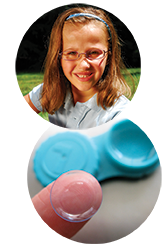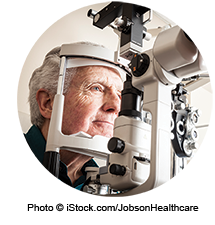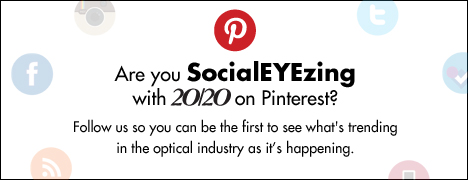|
Your monthly guide to staff training outside the box
Eyes / Lenses / Fitting Lenses / Free-Form / Frames / Sunwear / Patient Solutions/ In-office / Standards
IN-OFFICE: Differentiation
While there has been a proliferation of products and valuable segmentation in optical, it creates the dilemma of how to differentiate or separate you from the competition. Competition could be down the street, across town or online. What can make a difference?
—Mark Mattison-Shupnick
Proactive and Personalized in Optical
When patients leave your exam room and are handed off to the optical shop, does an optician not only greet them but also provide them with one-on-one attention? At my practice, which I run with my optician and office manager husband, Jason, one-on-one attention is the standard, even for those purchasing a value eyeglass package.
Offering a proactive and personalized approach to service in the optical also means being direct with patients about price. Some optometric practices take the view that you should hide the price until the patient is close to the checkout counter. We take a different view. We feel that patients appreciate having the price conversation up front. For that reason, Jason usually will ask the patient the price range he wishes to stay within. He also will calculate how much the patient’s vision benefit will cut the cost on a pair of eyeglasses, enabling the patient to stay within his price range while having as wide a selection as possible.
— Sherin George, OD
See Plus »
|
Designing Eyewear Based on Frame Styling
Johnna Dukes, ABOC
By taking charge of the frame selection process, you ensure your patient doesn’t choose a frame that isn’t a good partner to their prescription, virtually ensuring your patient makes a great decision. You’re helping make sure the frame fits properly, can be adjusted to their particular needs, and better still, you’re checking decentration to ensure the finished product will look great after their Rx is filled in that frame.
By sharing the information you know about how frames work with your patient, you are displaying your value. You are ensuring they are making a good spend of their money by making sure the frame they choose fits, looks great, is adjustable and is comfortable. For those of you who dislike frame styling, remember how important the frame is to how the finished eyewear works; the frame holds the prescription in place and is the delivery driver for ensuring the Rx works as prescribed. It’s a factor in the equation that is great vision.
See Plus »
|
|


|
Kids and Contacts

Linda Conlin, ABOC, NCLEC
Pediatric contact lens fitting is another area in which ECPs can offer unique products and services. A 2006 survey by Johnson & Johnson found that only 2 percent of practitioners fit contact lenses for children ages 10 and younger, and only 38 percent had prescribed lenses for children between 10 and 12 years old. Among the most common reasons they gave for reluctance to fit younger children were increased risk of noncompliance, lack of communication of problems and increased chair time. But how much of that is perception and not reality?
Consider the following: By age 2, children’s eyes are the same size as adults’ eyes, reducing the need for pediatric specialty lenses. Children tend to be healthier than adults and therefore have fewer systemic considerations for contact lens wear. Younger children tend to “follow the rules” and have closer adult supervision. According to a 2007 study of 84 children ages 8 to 12 and 85 children ages 13 to 17 newly fit with contact lenses, the younger group required only 15 minutes more chair time over three months.
The realities of fitting younger children with contact lenses made an impact because a subsequent study of optometrists found that 71 percent were currently prescribing lenses to children 10 to 12 years old, and 21 percent were more likely to fit that age group than they were the year before. Why the turnaround? The ODs cited children’s increased participation in athletics, increased interest in contact lenses at a younger age and increases in children’s confidence with contact lenses over spectacles.
See Plus »
|
An Introduction to Low Vision

Kara Pasner, OD
They say growing old is a privilege but growing up is optional. Regardless of how young we feel or act, age does take its toll on our bodies—our eyes notwithstanding. With age, there are ocular changes, which are considered “normal” and then there are changes, which aren’t. There are quantitative changes, such as a slight reduction in visual acuity, which are measurable in an eye exam. The other changes are qualitative changes, which are difficult to assess since they rely on a patient’s complaints. Usually they are complaints about a slight reduction in brightness, decreased contrast sensitivity, colors seeming duller and increased glare. These normal changes are relatively mild and can be perceived as an overall reduction in visual function—leaving some patients to say things like the familiar phrase, “I just don’t see as well as I used to.”
See Plus »
|
Promoting Sunglass Sales Through Social Media
Tim Slapnicher, ABOC
You’re familiar with Facebook by now. It’s a part of our culture for sure. People are staring down at their phones at the mall, the restaurant, the concert and definitely at your private practice. Even if you’re not on Facebook yet, you know about it and know how people get sucked in it for hours.
Use this to your advantage. If they’re staring at everything in their “feed,” have them stare at your optical and especially your sunwear. They won’t be interested in eye diseases, and they already know how trustworthy your optical is. So focus on sunwear. In fact, I believe for every five posts that private practices post on Facebook, three of the posts should showcase sunglasses. And it should all be client-driven.
Make sure to use at least one iPad (you’ll need tablets to do this effectively) in your optical shop dedicated to taking photos of your clients. Take photos of clients trying on sunglasses. Take photos of clients picking up their sunglasses. Have them take selfies—they love this. Take a video of their excitement, capturing that “ah-ha” moment of putting on polarized sunwear for the first time. You know how cool you are, but when your clients are doing the bragging for you, your credibility goes much further.
See Plus »
|
Benefits of In-Office Edging
Alex Bennett, ABOC
Edging ophthalmic lenses has come a long way from hand-edging glass lenses on ceramic cutting wheels; the newest revolution in edging systems is the development of automated multi-axis, computer-controlled routers that can accurately match the bevel of the lens to the frame groove. Some models can drill, edge groove, polish, pin bevel and even engrave lenses. While the up-front cost of these systems may be expensive, they can save your office money in the long run while increasing revenue.
The major benefits of offering an in-office edging system are to lower your lab bills and decrease your turnaround time to your patients.
See Plus »
|
The Store is the Stage
Mark Mattison-Shupnick, ABOM
“The store is the stage, with scenery, lighting and music…”
Imagine as you walk into your store, that all of a sudden your store is a theatre. Where everything counts, the setup of the store is the scenery in which you communicate with the eyewear consumer.
Imagine your role, and how important your role is in that specific theatre and whatever you say, whatever you do can set the tone for the conversation. You can bring a frame to life, you can make a huge impact in somebody’s appearance, and you can be part of the compliments customers receive tomorrow as they go to church or a movie theatre, and they will think of you.
So you as an actor, bringing this frame to life, are going to be a very important part of the consumer experience in the context of the Art of Retailing.
See Plus »
|
Rimless: Whatever You Want It to Be
Look! Over there? What’s that on his face? It’s a square! It’s a circle! It’s whatever he wants it to be!
All right, maybe that’s a little sensational, but when it comes to rimless glasses, eyewear selection and image making really can be that exciting. With the current retro craze still yet to release its stranglehold on eyewear, sometimes it’s hard to lose sight of what all of those chunky plastics are really meant to do: distract from your face. True, this can be beneficial—thick frames smooth lines, distract from blemishes and can really bring out your eyes through some careful color coordination. Yet at the end of the day, people will be looking at your frames—not at you.
There is hope though, for those patients who want to define themselves and not allow their eyewear to do the work for them: rimless eyewear. True, vintage may be what’s in fashion right now, but as I’m oft to tell my patients, rimless eyewear has never really gone out of style—a subtle yet important distinction. Besides, a good weatherman can see which way the vane is blowing: Late ’80s and ’90s fashion has been slowly creeping back to life, and considering it was an era partially defined by subtle, often rimless eyewear, I have no doubt that rimless will be back at the intersection of “fashionable” and “stylish” soon enough. So why not go rimless?
—Preston Fassel, BS
See Plus »
|
|


|
|